Updating Vision Zero approaches
At the Montgomery County Greenfest at the end of April, the County's Department of Transportation had a big booth with a variety of exhibits on their pedestrian, biking, transit, and traffic safety initiatives.
The booth is a visual indicator of how much the agency has moved forward as for many years the agency had been focused primarily on facilitating automobile movement.
I had a long conversation with one of the staffers, which led me to write and share with them a memo on a more systematic approach to implementation of Safe Routes to School.
Plus, we discussed my reservations about the local traffic safety marketing program, Street Smarts (see "Safe Driving: April is National Distracted Driving Awareness Month"), which I find somewhat indirect in its messaging and more focused on bicyclists and pedestrians, and less on motor vehicle operators.
Also see "Why transit, biking, and walking as transportation is so hard for most Americans to understand? Because most people drive" and "It's time to take action on road safety: Recent pedestrian and cyclist deaths show drivers are becoming a menace," Toronto Star.
A week or two later I was thinking about that conversation in the context of the "Vision Zero" approach to traffic safety generally and in the city, and I realized that I could add a couple items to the previous framework I had developed (updated here, "DC and Vision Zero Revisited," and originally discussed here, "A "Vision Zero" agenda for DC").
Plus I realized it would be better to reorganize it along the lines of the 5 E's of active transportation planning: Engineering; Education; Encouragement; Enforcement; Evaluation, but reordered and with a 6th E added for Equity ("Revisiting bicycle (and pedestrian) planning and the 6th 'E': equity").
Planning/Placemaking
This element is called "Evaluation" in the traditional 5 E's framework, and typically this is listed last while it should be listed first, as it is here.
1. Engage citizens in the Vision Zero process from the outset. Focus on capacity building.
2. Develop a systematic planning approach at the sub-city scale for addressing traffic safety matters, including requiring school districts to incorporate mobility planning for pedestrians and bicyclists. Traffic calming programs need to be rolled into such initiatives.
(DC DOT has a program called "Livability Planning" but in my estimation, it's not at the level of a standardized program, and the results are only as good as the project manager and participants, so it's a crapshoot.)

WalkDenver is a community organization we need to pay more attention to as an example of national best practice examples. Check out this infographic on the West Colfax neighborhood, calling attention to gaps in sidewalk network there
-- West Colfax Walk Audit final report
4. Ensure that neighborhood planning protocols address night-time safety and lighting issues in a systematic fashion ("Night-time safety: rethinking lighting in the context of a walking community").
5. Create Ward-specific traffic safety committees (walking, biking, neighborhood) that would function as ward-specific subcommittees of the city's standing Pedestrian and Bicycle Advisory Committees, to develop and focus on implementing a ward-wide improvement agenda.
6. Collect, maintain and present detailed data on all traffic accidents of all types and put it in real-time on the DDOT Dashboard.
Note that while the execution isn't fully successful, the Metro newspaper in Toronto is doing this as part of a traffic safety campaign ("Which roads are deadliest? Metro maps pedestrian and cyclist deaths") and I think that all cities, including DC, ought to move towards that kind of approach to data presentation, for all crashes/accidents, not just deaths.
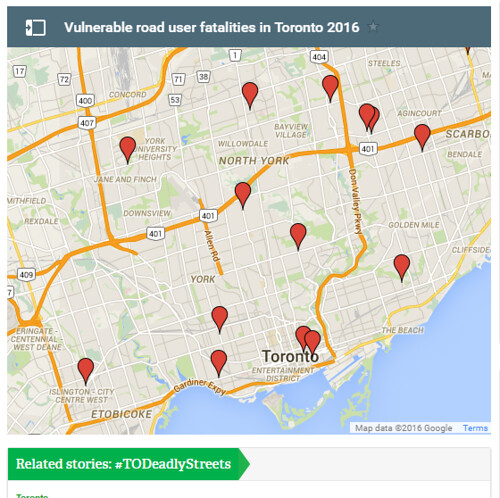
7. My "Signature Streets" approach is a way to reorganize planning around sustainable mobility and traffic safety. See "Minneapolis North Side Greenway project as a quantum leap in transportation-placemaking-greenway-trail-parks planning" and "Complete Places are more than Complete Streets" for discussion of this concept.
Engineering and Maintenance (physical infrastructure and improvements)
Note that most traditional road safety infrastructure treatments for motor vehicle traffic tend to be standard practice in the Walking City (L'Enfant) urban design that typifies Washington, DC. With regard to roundabouts, I'd argue that they are designed to facilitate automobile throughput, not to improve pedestrian and cyclist safety.
8. Prioritize design treatments that preference pedestrians and bicyclists and transit users in the context of the Walking and Transit City ("Transportation and Urban Form" by Peter Muller). This means more pedestrian scrambles and bike boulevards. Also see "Barnes Dance Intersections as possible "solutions" to Wisconsin & M, 14th and U intersections."
And implement them.
9. Formalize the development of a "Safe Routes to Transit" planning protocol.
This pedestrian scramble at Hollywood and Vine in Los Angeles was a model for the Santa Monica program. Photo: LA Great Streets program website.
As part of the integration of the Expo Line into Downtown Santa Monica, they installed pedestrian scramble intersections at transit stations ("Santa Monica Is Getting 11 Pedestrian-Friendly Crosswalks That Stop All Cars At Once," LAist).
That's the kind of approach that needs to be taken in terms of rebalancing mobility towards pedestrians in high use pedestrian areas.
10. Change roadway materials (from asphalt to Belgian Block, etc.) for the streets around pedestrian predominated places e.g., commercial districts, parks, squares and circles, libraries, and Metrorail stations to make clear that these are pedestrian prioritized places.
The Big Dig in Boston was an example of a tunnel project focused on removing through traffic from surface streets.
11. When possible, separate through traffic from arterials that are also neighborhood serving. See "London Mayor proposes roadway tunnels to divert surface motor vehicle traffic and congestion."
12. Support the (re)development of dedicated transitways for surface bus service.
13. Analyze all traffic accidents and incorporate the PEDSAFE and BIKESAFE Safety Guide and Countermeasure Selection Systems and other traffic safety analysis protocols to shape physical and programmatic changes as necessary, when structural-design problems have been identified.
14. Install more pedestrian-focused lighting in pedestrian areas to address night-time safety.
15. Change winter snow clearance practices to support walking, biking, and transit use ("Planning for winter weather").
16. This isn't an issue in DC, but in those communities where residents are financially responsible for paying for and building sidewalks, local governments need to take the lead to ensure the creation of complete sidewalk networks ("A walking (or sustainable mobility prioritized) city should take responsibility for constructing sidewalks").
Education
17. Develop and deliver a curriculum for traffic safety (bike, walk, transit, drive) for K-12 schools: elementary; junior high; and senior high schools. Note the inclusion of high schools.
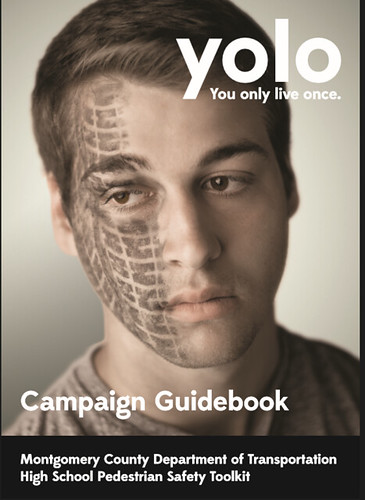 Typically SRTS programs focus on elementary schools and maybe middle schools, while high schools are not addressed. Yet the number of adolescent injuries and deaths related to traffic safety remain persistently high. Therefore, SRTS and traffic safety programs need to be provided to high school aged populations.
Typically SRTS programs focus on elementary schools and maybe middle schools, while high schools are not addressed. Yet the number of adolescent injuries and deaths related to traffic safety remain persistently high. Therefore, SRTS and traffic safety programs need to be provided to high school aged populations.-- The Yolo campaign -- You Only Live Once -- developed by MCDOT and the StreetSmart program is a developing best practice.
-- Rosemount High School in Minnesota has a SRTS plan
-- Seattle's SRTS mapping includes junior and senior high schools
-- Montgomery County and Pennsylvania have mini-grant programs for traffic safety education targeting high school demographics and groups.
18. Work with colleges, recreation centers, senior organizations, etc., to provide programming as needed for adult populations. Most recreation and community centers could offer such programming but don't. Space ought to be provided to bicycle co-op programs in community/recreation centers so that they can deliver their programs without having to spend most of their time fundraising for rental space.
19, Develop a Vision Zero related set of questions that must be taken as part of the drivers license renewal process. Generally, after a person receives a drivers license, they are not re-tested. Re-tests could be given at license renewal in order to reinforce public policy goals concerning traffic safety.
Note that Idaho has added two such questions to their driver's license test, effective this year ("Idaho driver's test now asks you about bikes, pedestrians," Idaho Statesman).
20. Develop better traffic safety social marketing.programs. The NYC Vision Zero program is particularly direct ("Lessons from New York on how to eliminate traffic deaths," Metro Toronto) in their marketing program. From the article:
New York’s graphic Vision Zero ads — on television, radio, YouTube, bus shelters and billboards — don’t settle for a broad safety warning to drivers, cyclists and pedestrians. Instead, they single out drivers in a blunt tone unthinkable from Toronto’s government. One typical ad on bus shelters shows a woman’s bloody arm on the pavement. The text: “She waited for the signal. The driver didn’t.”According to NYC, 70% of pedestrian deaths there are the fault of "driver's choices."
I also like the idea of using buses and railcars as big rolling billboards, with very direct messages.
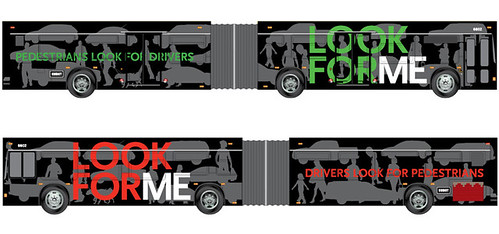
bus wrap, Pedestrian safety campaign, New Mexico
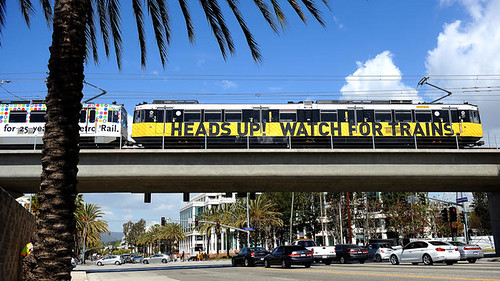
Heads up Watch for Trains banner on Expo Line light rail train, Los Angeles. LA Times photo.
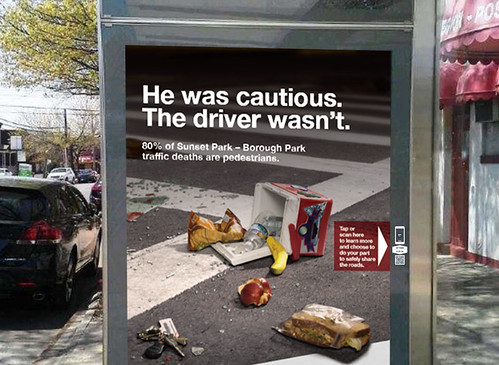
Many of the ads in the NYC Vision Zero campaign use micro-targeting, providing very specific localized information about crashes and deaths in the area.
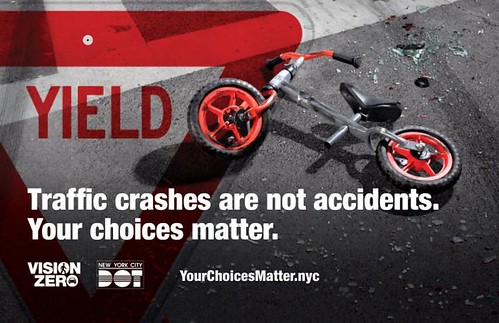
21. Require specialized training for heavy vehicle operators (e.g., concrete trucks, dump trucks, etc.) with regard to driving in urban conditions, and with pedestrian and bicycle traffic. Most transit agencies do this. In DC, heavy vehicle operators (DPW, DDOT, DC Water) go through this training.
22. Extend driver education "refreshment" training through partnerships with large employers. Minnesota is doing this ("Minnesota law enforcement turns to employers in curbing distracted driving," Minneapolis Star-Tribune). From the article:
Major employers such as General Mills, Ecolab and CHS ban employees from using mobile phones and texting while driving company-owned vehicles and have comprehensive safety programs to promote safe driving. They’re using e-mail blasts, articles in company newsletters and videos and articles on internal websites.Encouragement
At Cargill, where safety messages come in the form of posters in parking ramps and lots that carry messages such as “Hang Up, We Want to See You Again Tomorrow,” employees are required to complete e-learning courses and sign a commitment pledging safe driving. That means no use of cellphones while driving on campus, no texting while driving anywhere while on company business, even in personal vehicles, and 13 other behaviors deemed detrimental to driving safety. Violations bring consequences.
“It’s expected behavior” while on the clock, and the hope is that it continues when employees are on their own time, said Melanie Burke, Cargill’s director of health and safety. “It’s a goal to make it part of the culture.”
Fryklund said Cargill’s safe driving push has led to a behavior change. Fryklund, who works in the company’s animal nutrition division, said he always wears his seat belt and now tucks his cellphone in the seat behind him so he can’t get to it when it vibrates.
23. Develop city-wide/county-wide "Open Streets" events like the CicLAvia in Los Angeles, which is probably the nation's most successful (and is modeled after the Ciclovia program in Bogota, Colombia). CicLAvia regular gets 100,000+ participants at their seasonally-scheduled events. And Park(ing) Day is another example, another good way to educate people on these issues.
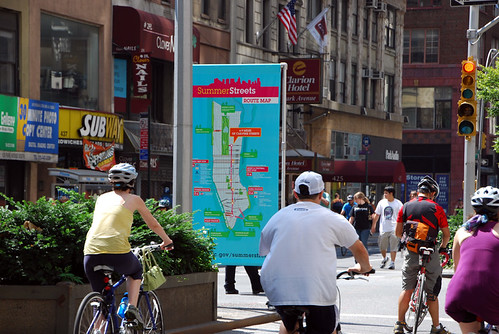
Photo of a New York City Summer Streets program by BeyondDC.
24. Develop and deliver ward/neighborhood walk and bike events on a seasonal basis in association with the Department of Parks and Recreation, Department of Transportation, and other agencies and civic groups.
25. Provide financial support to walking, bicycling, and transit advocacy groups. Best practice groups as models include Feet First in Seattle, WalkDenver, WalkBoston, Transportation Alternatives in NYC, Starkville in Motion in Mississippi, City Repair in Portland, the Active Transportation Alliance in Chicago, and the Better Block model.
Enforcement/Traffic Engineering
In this section I've added traffic engineering as an element slightly different from the kinds of infrastructure facilities typically covered under the "Engineering" E.
NYC Vision Zero ad. Suburban residents often don't realize that it is inappropriate to drive fast in urban environments.
26. Put signage up at the major entry points into the city, stating that the prevailing speed limit is 25 mph, unless posted otherwise.
27, Make residential street speed limits 20 mph.
28, Change the speed limit around transit stations to 25 mph (or 20 mph).
29, Post notification signs at locations of traffic deaths.
Image from Streetsblog.
30. Change the legal framework with regard to motor vehicle operation to require that automobiles--as the heaviest and most powerful mobility device--should be accorded the greatest amount of legal responsibility with regard to traffic accidents.
31. Up the penalties for vehicle accidents that injure, maim, or kill, regardless of intent.
32.. Retrain police officers with regard to bike and pedestrian accident analysis so that their default position is not "the pedestrian/the bicyclist is automatically at fault."
33. Legalize the Idaho Stop for bicycling
34. Consider the development of a bicycle operators endorsement for drivers licenses.
35. Bring back the traffic enforcement division of the police department as a special unit. (Note that the Motor Carrier Safety Unit still exists, although it's probably a federal requirement.)
36. Give parking enforcement officers the training and legal authority to ticket driving infractions.
37. Advocate to the Consumer Product Safety Commission for the inclusion as original equipment front and back lighting, and left and right turn signals on bicycles intended for urban transportation use
Equity
38. Invest extra time and money in developing and delivering programming targeting lower income demographics, people of color, and immigrant communities. This post, "Urg: bad studies don't push the discourse or policy forward | biking in low income communities," has many examples of better practice programming. This article from Canadian Immigrant discusses a program focused in Canada ("A Toronto program uses two wheels to connect newcomers to the city").
39. Develop a mini-grant program for capacity building and traffic safety programs for community groups working with these populations. Besides the Montgomery County and Pennsylvania programs mentioned above, Toronto's small grants program for "Bicycle User Groups" is another example.
Labels: car culture and automobility, public safety, public space management, traffic engineering, traffic safety and enforcement, transportation planning, urban design/placemaking








17 Comments:
This is where I want to go all T rex and tear up the entire list.
Biking and walking in urban environments is safe. I'm far more worried about being mugged than run over.
We are talking very incremental improvements and not much crossover benefits.
(The stupid new rules removing countdown timers is an example of that. Very good for all street users).
I'd say the biggest thing you can do is have a camera than can detect right turns on red.
For biking obviously not quite so simple. Honestly with bikeshare the biggest thing is forcing the bike station to be on the same side of the street as bike lanes so you don't have to cross over. DDOT / Alta very resistant to thinking on micro issues on placement. I understand the solar thing but that is really again a technical excuse for a bad architecture.
Other big thing is shade -- which makes walking much easier.
T rex mode off for now, sorry.
what's up with new rules "against" countdown timers?
I don't know about that. I agree with you about it being a wrong move.
2. wrt t rex, you know me, it's just about being thorough.
If we're going to do vision zero approaches, then it should be through a systematic approach, rather than half assed -- like the point in the Keenan column where he writes that while on talk radio people are content to ream bicyclists and pedestrians, the reality is that motor vehicle operators are at fault most of the time. (In NYC with ped accidents, 70% of the time drivers are at fault.)
3. I do agree with you that relatively speaking, walking and biking is 'safe' in the city. But that doesn't mean that it is safe enough.
And more importantly, when it isn't safe it's usually because of motor vehicle operators. Hence the need for more focused planning, programming, and messaging.
=====
Plus, I just updated it because I had been thinking about related issues.
AND, because I tried to get this firm that I really like to bid on the Street Smarts marketing program. They considered it, but the timing was wrong for them given the timing, tender period and their current commitments.
So that made it even more on my mind.
Hmm, ok, on the SS marketing -- that is the tire track on people program?
Which is a great example of an advertising program that makes the creatives look good -- it sticks in your mind -- doesn't accomplish the goal.
And you're limited by the choice of media -- I see most of it as outdoor displays rather than more interactive.
I'd draw up a matrix/box.
And invent new choices of media.
The "Bike ambassador" that they were writing in bike lanes was good.
The little messages on the actual bikeshare bikes are helpful too.
Even using twitter/social media to name and shame offenders can be helpful. (might be out of your area of comfort)
yep, the tire tracks. And yes, it is mostly outdoor. I'd like to see a renegotiation of the Clear Channel contract and using some of the digital ad space in bus shelters. And tv/cable.
don't know about bike ambassador stuff.
like with bikehare bike messages, the bike maps have messages, which is why they need to be converted to signage posted up in various places.
In the memo on SRTS that I wrote (I may put it up in the blog, but it is long), I mentioned how the SRTS maps produced by orgs. like Seattle have been converted into brochures by Palo Alto, and the Palo Alto brochure is a good example of how that brochure could be converted into a map sign and placed in school lobbies, etc.
Those kinds of conversions, in office building lobbies, etc., is another way to spread the message.
Plus the Minnesota program focusing on large employers and their employee bases.
fwiw, I have no problem with shaming messages, but it could get out of hand.
note that Howard County (maybe I should add this to the next iteration) has a program where you can tell them about an offense, and even though they can't write a ticket, they send a letter to the address on the vehicle registration, saying that X was reported, that this is a problem and dangerous, and that it needs to stop.
There's something to be said for that.
http://urbanplacesandspaces.blogspot.com/2011/02/howard-county-police-department-best.html
2. what is the deal with the ped countdown clocks?
http://www.nytimes.com/2016/05/23/science/its-no-accident-advocates-want-to-speak-of-car-crashes-instead.html?_r=0
yes - you need to cut down on those long memos!
One pager! no more!
Ok, so you are taking your leveraging scale argument -- have a consistent message up and down the media ladder -- and save money on the design and what not?
On countdown timers, I can't find a quote.
http://www.streetsblog.org/2015/06/16/the-nyc-traffic-rule-thats-completely-at-odds-with-how-people-walk/
Basically the new MUTCD rules and pedestrian advocates don't like countdown timers any more, when in reality they are a win for all users.
http://www.waba.org/programs/d-c-bike-ambassador/
http://www.washingtoncitypaper.com/news/article/13044887/stencil-pusher-behind-dc-bike-lane-graffiti
I was trying to suggest a matrix, basically something like
Walking/Transit City / car city
Traditional media intersections / billboards
Guerrilla Media post it notes / social media
Although like all Matrixs looks stupid when you draw it out.
- will look more into the timer issue, I didn't know. I remember being very positive in Balt. County when they said it was the new standard practice.
I agree with you it is misguided to change. It provides "actionable" info that is very helpful.
- don't knock yourself on the matrix. I think such visual constructs are good for organizing thinking. Sure it needs work but everything does.
- wrt to "traditional media intersections" I am big on what the industry calls "Out of Home" or "Outdoor" and especially the creation of new "public service messaging media delivery systems" within that existing framework, from bus shelter ads to the ad systems in office building elevators.
The problem is that all of those entities are disconnected, it isn't one system.
cf. the "problem" with TransitScreen is that it really needs to be conceptualized as a "medium", and combined with an ad stream etc., such as the ad stream in a bus shelter.
WMATA ought to be doing that with its in-station ads, in bus shelters they control (which have no ads at all).
They have "an ad" for the Safe Track on the displays affixed to the station manager kiosks. While that is the wrong place for ads, its one element of what could be included in that "public service messaging system."
I've been thinking about it for 10+ years, first focused on websites. But I've never managed to pull together ad and computer people. LinkNYC could do it but it isn't part of their program.
But think of that as a system of kiosks and including my PSMS as part of it. (Similarly the MTA kiosks could do this and they don't, they don't even have localized visitor info keyed to a station.)
Or there are digital screens in libraries like DCPL (and other places). They could have more of this.
Similarly, there is a digital screen in the Silver Spring Veterans Center that cycles through community ads (mostly govt. related), TransitScreen info, map of Downtown Silver Spring, map of the Metro and bus station, etc.
I wrote an memo to APCO back in about 2002 trying to get a job there --I basically invented a scenario where where you'd have online "friends" based on a reputation server where news and other information would be moved.
Crazy ideas. Nobody wants to be 10 years out in the future.
Yet.
Grabbing the electric bus shelters ads based on geographic location of hazard zones would be good. The new sort of working WMATA next bus electronic signs can also do something.
You'll notice the highly annoying "this bus is 1.75" spoken messages now so the technical ability is there.
(Esther Dyson had a proto-version of that idea in Release 1.0 back in the early 1990s. I used to read it at the LC when I was doing computer-related tv programming with PBS's satellite division. Twitter is like that now. Or an instagram feed. I don't use either that much, which probably limits my reach.)
wrt bus shelters and transit stations they just need to be geocoded. And they are anyway, but you have to build a zone.
In transit planning they have what they call TAZs or Traffic/ Transportation Analysis Zones, or there is the Census Block Group, smaller than a census tract.
Anyway, it's easy enough to do that and then you could just push out transit info and community/public service media that way. Along with a regular ad stream.
DC's RideDC app could do that but it has a bunch of problems. TransitScreen does it.
I was looking at the thing in Silver Spring Civic Center just now, and it's set up to have bike share, car share, Silver Spring Metro, and then it is coded for a set of particular bus stops--the bus level info is not by bus number (for either RideOn or Metrobus) but by bus stop.
(Note that it doesn't include MARC or Amtrak. I can see not including Amtrak, but MARC ought to be included.)
With the same geocoding system you could have "city scale", public service ads, and neighborhood/district specific based on the code, e.g., dif. community messages for Takoma Station vs. Eastern Market station, but the same citywide announcements.
2. but speaking of losing a decision access point for a generation, DC did the bus shelter contract in 2005 for at least a 20 year period. They didn't build this in. (They do get some ad slots though here and there, mostly in suboptimal locations.)
I don't know how the contract deals with new technologies. E.g., when it was made probably nothing was included about changing the payout based on adding digital advertising. (in California, some cities are being offered 52% of the proceeds, to agree to digital billboards).
In any case, doing contracting that way makes it very difficult to be innovative and flexible.
3. I suppose with the geocoding you could also have a "interest type" e.g., resident vs. office worker, e.g., different stream of items for an employee downtown vs. an employee/resident.
Right, so what you are doing is pushing a version of ad-tech auctions into the public space area?
https://en.wikipedia.org/wiki/Real-time_bidding
http://marketingland.com/martech-landscape-what-is-programmatic-ad-buying-157453
Sorry if my comments aren't very useful -- been focusing the energy on the homeless shelter issue and it is draining. As is the realization that while I've said Arlington is communist china it really is singapore (one party, pretty honest) and DC is Communist China (one party, every is in for a 10% cut).
interesting comparison. In DC, the Councilmember job is full time with great wages, but considered part time so outside income is ok.
Lots of graft/money sloshing through the system, e.g., the David Wilmots (remember the homes for the disabled he ran, and he and his friends got paid hundreds of thousands to manage/be on the board).
Not that it maybe would make that much difference, but that's why I am big on process/structure/systematizing things.
I've been meaning to write a piece, but now it might not matter, about the failure of the Childrens and Youth Trust.
I was always against it. It just set up another method for elected officials to pressure an organization to steer monies.
Just set up a standardized open transparent process and open it up for applying.
That's how just about any govt. does it.
... although many usually also have a discretionary fund/tranche for councilmembers to give out.
In NYC it's about $1.5 million/year (not much for NYC). And some of the Councilmembers do it via participatory budgeting.
The homeless thing is a massive failure of the capital budgeting process, which is laughably immature in DC. There's no excuse for it. None.
wrt the public space thing, again, it's about a system of displaying/placement within existing systems, not setting up new appurtenances in the public space like how in Montreal there are big ad kiosks.
https://www.pinterest.com/astralooh/street-column/
report by Toronto Public Health on pedestrian and bicycle safety.
http://www.toronto.ca/legdocs/mmis/2015/hl/bgrd/backgroundfile-81601.pdf
Monica Campbell, director of healthy public policy at Toronto Public Health, explained that lower speeds don’t just reduce the force of impact in collisions, they make it easier for drivers to avoid crashes in the first place.
“If you’re travelling quickly, you have a very narrow range of vision,” she said. Travelling at slower speeds allows drivers to have a better view of what’s happening. That enables them to stop sooner and to spot hazards such as someone darting out from behind a parked car.
https://www.thestar.com/news/pedestrian-road-safety/2016/12/11/most-pedestrian-deaths-occurring-outside-torontos-road-safety-plan-analysis.html
The increase in pedestrian deaths has been a big issue in Toronto. Both the Toronto Star and Globe & Mail have focused on it.
TGM analysis found a high proportion of deaths were seniors, and that deaths were more common with minivans/SUVs, with the hypothesis that the vehicles are higher, and more likely to hit a pedestrian with more force, and in the torso, as opposed to the legs.
http://www.theglobeandmail.com/news/toronto/more-than-160-pedestrians-killed-by-vehicles-since-2011/article30391640/?ord=1
http://www.theglobeandmail.com/news/toronto/in-toronto-its-difficult-for-seniors-to-cross-the-street-both-slowly-and-safely/article33688567/
CTA has a public transit safety program for elementary schools:
https://www.cjr.org/analysis/when-covering-car-crashes-be-careful-not-to-blame-the-victim.php
n the summer it is so hard to navigate around those areas however the extended curbs and painted walkways help alert drivers to be aware at all times. I love the proactive approach taking with becoming a leader in safety and becoming a sustainable community in terms of the environment. Good work Brett Troop !!traffic calming,traffic calming devices.
Post a Comment
<< Home